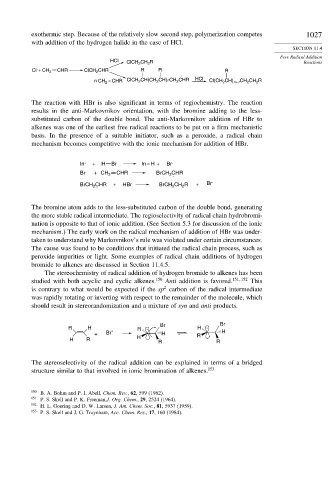Page 1043 - Advanced Organic Chemistry Part A - Structure and Mechanisms, 5th ed (2007) - Carey _ Sundberg
P. 1043
exothermic step. Because of the relatively slow second step, polymerization competes 1027
with addition of the hydrogen halide in the case of HCl.
SECTION 11.4
Free Radical Addition
HCl ClCH 2 CH 2 R Reactions
. R R
Cl +CH 2 CHR ClCH 2 CHR R
. .
n CH 2 = CHR ClCH 2 CH(CH 2 CH)nCH 2 CHR HCl Cl(CH 2 CH) n+1 CH 2 CH 2 R
The reaction with HBr is also significant in terms of regiochemistry. The reaction
results in the anti-Markovnikov orientation, with the bromine adding to the less-
substituted carbon of the double bond. The anti-Markovnikov addition of HBr to
alkenes was one of the earliest free radical reactions to be put on a firm mechanistic
basis. In the presence of a suitable initiator, such as a peroxide, a radical chain
mechanism becomes competitive with the ionic mechanism for addition of HBr.
In . + H Br In – H + Br .
Br . + CH 2 CHR BrCH CHR
.
2
.
BrCH CHR + HBr BrCH CH R + Br
2
.
2
2
The bromine atom adds to the less-substituted carbon of the double bond, generating
the more stable radical intermediate. The regioselectivity of radical chain hydrobromi-
nation is opposite to that of ionic addition. (See Section 5.3 for discussion of the ionic
mechanism.) The early work on the radical mechanism of addition of HBr was under-
taken to understand why Markovnikov’s rule was violated under certain circumstances.
The cause was found to be conditions that initiated the radical chain process, such as
peroxide impurities or light. Some examples of radical chain additions of hydrogen
bromide to alkenes are discussed in Section 11.4.5.
The stereochemistry of radical addition of hydrogen bromide to alkenes has been
studied with both acyclic and cyclic alkenes. 150 Anti addition is favored. 151 152 This
2
is contrary to what would be expected if the sp carbon of the radical intermediate
was rapidly rotating or inverting with respect to the remainder of the molecule, which
should result in stereorandomization and a mixture of syn and anti products.
Br Br
R H . R . H .
+ Br H R H
H R H
R R
The stereoselectivity of the radical addition can be explained in terms of a bridged
structure similar to that involved in ionic bromination of alkenes. 153
150
B. A. Bohm and P. I. Abell, Chem. Rev., 62, 599 (1962).
151 P. S. Skell and P. K. Freeman,J. Org. Chem., 29, 2524 (1964).
152 H. L. Goering and D. W. Larsen, J. Am. Chem. Soc., 81, 5937 (1959).
153
P. S. Skell and J. G. Traynham, Acc. Chem. Res., 17, 160 (1984).

